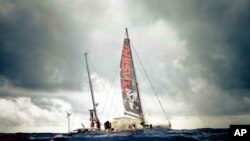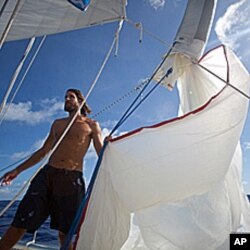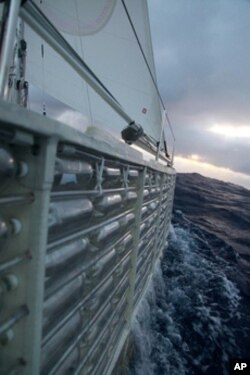A British adventurer is spreading his own message in a bottle by crossing the Pacific Ocean aboard an 18-meter catamaran made of thousands of plastic soda bottles.
David de Rothschild's unusual boat is his way of drawing attention to the plastic polluting the world's oceans while also showcasing a solution. The 31 year old hopes to inspire followers with the boat he calls the "Plastiki."
Global mission
"We're on a mission to beat waste," says de Rothschild. "The Plastiki project is really trying to showcase that waste is inefficient design and that we can reuse everyday materials and rather than them ending up in landfill, or in our oceans, or being incinerated and ending up in our atmosphere, we can repurpose and build items that can be reused so we can close the loop."
After reading a United Nations report about the huge swirls of plastic trash in the oceans, the British banking heir thought up the expedition to draw attention to the problem.
The name Plastiki echoes the Kon-Tiki, the raft that Norwegian anthropologist and adventurer Thor Heyerdahl built to cross the Pacific in 1947.
His grandson, Olaf Heyerdahl, was one of six crew members on the first leg of the Plastiki voyage, from San Francisco to Christmas Island.
The design
It took three years to design and build the unique vessel. De Rothschild says they learned a lot during the process.
"One of the breakthroughs of the project; we actually had to reenergize every bottle with a little bit of CO2," he says. "So imagine if you had a soda bottle and you were to shake it up before you opened it up. It becomes very, very hard. That's the carbon dioxide inside fizzy drinks that allows a bottle to stay so rigid. So we just put the powder inside and that basically allows each bottle to act as an individual buoyancy chamber."
De Rothschild, founder of Adventure Ecology — a London-based environmental education group — brought ecology-minded features to all aspects of the expedition, starting with the Plastiki's design and construction.
"That meant inventing an unlikely but effective glue made of sugar and the husks of cashew nuts to hold the plastic parts together. It also meant installing sophisticated solar cells and a human-powered bicycle on board to power communications equipment as well as provisioning the crew of six with fresh vegetables from a hydroponic garden."
The provisions were designed to last 110 days, and in mid-June with one month left before reaching Sydney, the crew was still eating fresh, organic food from San Francisco. But when water ran low, the crew chose to drink it rather than water the garden, which wilted.
"It provided us quite a lot on the first leg with an amazing fresh supply of chard and rainbow kales and dark leafy greens which are great nutrients and great for the mind," says de Rothschild.
Adapting
The Plastiki had to prove its seaworthiness on the planet's biggest body of water.
It hasn't always been smooth sailing. During the vessel's first 8,000 kilometers, the catamaran moved somewhat sideways, a little bit like a land crab, because it was built without a keel. That made it difficult to steer. When the Plastiki reached its second port of call, Samoa, de Rothschild made needed repairs and adaptations to the boat, including adding a rudimentary retractable keel.
The voyage, combined with intense tropical heat, caused some material to shift and soften. Workers changed all of the rigging from stainless steel wire to lightweight rope and reinforced the two hulls, putting a layer of aluminum over the original recycled plastic material. It was a reluctant bow to the realities of an experimental vessel that needs to be ready in time to face the Australian winter ahead.
The boat also traveled more slowly than de Rothschild had hoped, leading to discomforts beyond the relentless exposure to sun and salt and lack of bathing facilities.
"There are days when the boat is barely moving, like right now, when we've been sailing almost on the same spot for the last 24 hours," he says by satellite phone in the South Pacific, en route from San Francisco to Sydney, Australia.
"That becomes a little bit of a challenge mentally. When you start to think about the enormity of how far we've got to go — another 2,800 miles at least to Australia — that does become slightly wearing and tearing."
Spreading the message
The crew lives on a six-by-18 meter covered platform suspended between the two hulls. When not sailing the vessel, the crew members blog on the Plastiki website, post photos on Flickr and videos on YouTube, and take questions from followers on the boat's Facebook page. All the while, they send a message about plastic pollution in the ocean.
The feedback comes in almost instantaneously. Like from a conversation via skype with 150 children at the Fort Worth Museum of Science and History in Texas. They had just walked through a tunnel built from 8,000 plastic bottles called, "Sea 'n' Recycle: In Honor of Plastiki."
The feedback has made a difference in de Rothschild's plans for the Plastiki itself after the journey is finished in July.
He originally planned to recycle the boat in Australia. But an international outpouring of interest in its use for educational purposes convinced him to keep it afloat, at least for a few more years. Its first stop will be the Australian Maritime Museum at Darling Harbor.











